Essay: Non-Protein Coding Regions of Genome in Common Genetic Disease
VerifiedAdded on 2023/04/25
|8
|2122
|321
Essay
AI Summary
This essay discusses the significant role of non-protein coding regions of the genome in the development of common genetic diseases. It highlights that while only a small percentage of the DNA genome comprises protein-coding genes, the non-coding regions play a crucial role in gene regulation through elements like promoters, enhancers, silencers, and insulators. These elements influence transcription by providing binding sites for proteins and RNA molecules. The essay further explores how mutations and variations in these non-coding regions can disrupt normal gene regulation, leading to various diseases, including cancer and Parkinson's disease. Specific examples, such as the FTO allele's association with obesity and the impact of non-coding variants on alpha-syncline expression in Parkinson's, are discussed. The essay concludes by emphasizing the need for advanced data analysis tools and genome sequencing to evaluate variants in non-coding regions for improved disease diagnostics and treatment, and emphasizes the importance of population data in evaluating variants and the relevance of regulatory elements to patient phenotype. Desklib offers a platform to access this essay and other solved assignments for students.

UNIVERSITY
NAME
STUDENT ID
COURSE CODE
COURSE NAME
ASSIGNMENT
Part A
NAME
STUDENT ID
COURSE CODE
COURSE NAME
ASSIGNMENT
Part A
Paraphrase This Document
Need a fresh take? Get an instant paraphrase of this document with our AI Paraphraser
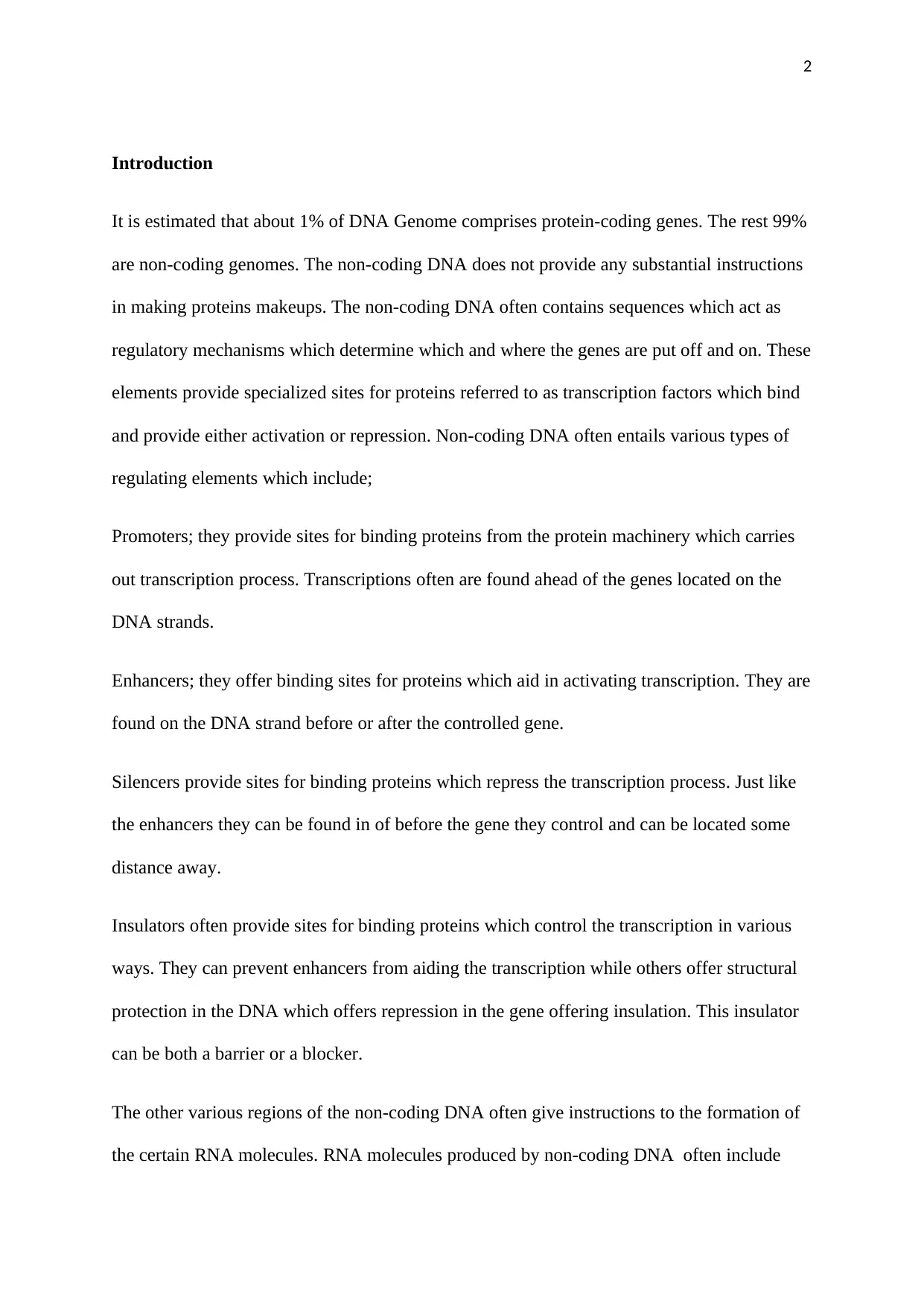
2
Introduction
It is estimated that about 1% of DNA Genome comprises protein-coding genes. The rest 99%
are non-coding genomes. The non-coding DNA does not provide any substantial instructions
in making proteins makeups. The non-coding DNA often contains sequences which act as
regulatory mechanisms which determine which and where the genes are put off and on. These
elements provide specialized sites for proteins referred to as transcription factors which bind
and provide either activation or repression. Non-coding DNA often entails various types of
regulating elements which include;
Promoters; they provide sites for binding proteins from the protein machinery which carries
out transcription process. Transcriptions often are found ahead of the genes located on the
DNA strands.
Enhancers; they offer binding sites for proteins which aid in activating transcription. They are
found on the DNA strand before or after the controlled gene.
Silencers provide sites for binding proteins which repress the transcription process. Just like
the enhancers they can be found in of before the gene they control and can be located some
distance away.
Insulators often provide sites for binding proteins which control the transcription in various
ways. They can prevent enhancers from aiding the transcription while others offer structural
protection in the DNA which offers repression in the gene offering insulation. This insulator
can be both a barrier or a blocker.
The other various regions of the non-coding DNA often give instructions to the formation of
the certain RNA molecules. RNA molecules produced by non-coding DNA often include
Introduction
It is estimated that about 1% of DNA Genome comprises protein-coding genes. The rest 99%
are non-coding genomes. The non-coding DNA does not provide any substantial instructions
in making proteins makeups. The non-coding DNA often contains sequences which act as
regulatory mechanisms which determine which and where the genes are put off and on. These
elements provide specialized sites for proteins referred to as transcription factors which bind
and provide either activation or repression. Non-coding DNA often entails various types of
regulating elements which include;
Promoters; they provide sites for binding proteins from the protein machinery which carries
out transcription process. Transcriptions often are found ahead of the genes located on the
DNA strands.
Enhancers; they offer binding sites for proteins which aid in activating transcription. They are
found on the DNA strand before or after the controlled gene.
Silencers provide sites for binding proteins which repress the transcription process. Just like
the enhancers they can be found in of before the gene they control and can be located some
distance away.
Insulators often provide sites for binding proteins which control the transcription in various
ways. They can prevent enhancers from aiding the transcription while others offer structural
protection in the DNA which offers repression in the gene offering insulation. This insulator
can be both a barrier or a blocker.
The other various regions of the non-coding DNA often give instructions to the formation of
the certain RNA molecules. RNA molecules produced by non-coding DNA often include
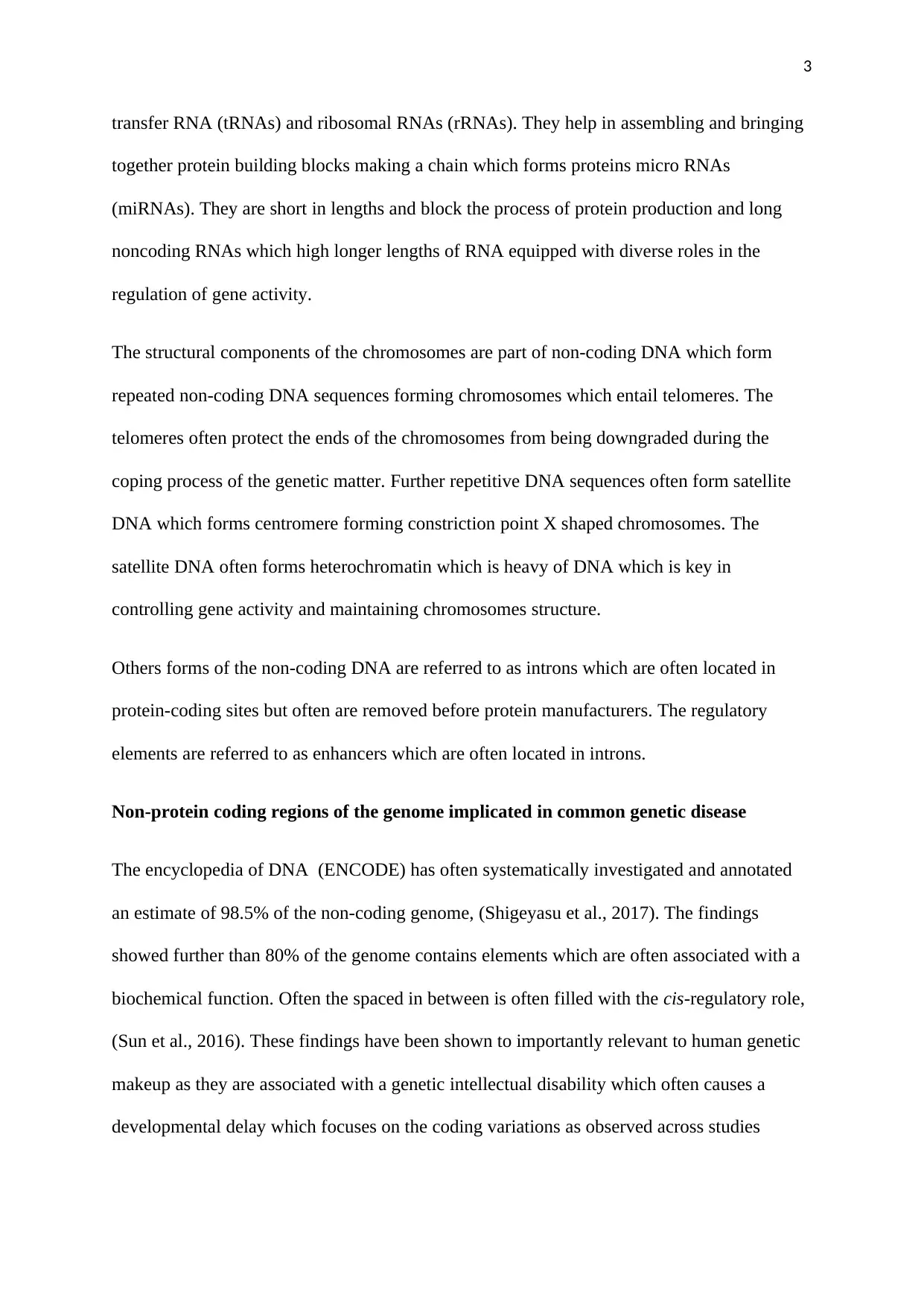
3
transfer RNA (tRNAs) and ribosomal RNAs (rRNAs). They help in assembling and bringing
together protein building blocks making a chain which forms proteins micro RNAs
(miRNAs). They are short in lengths and block the process of protein production and long
noncoding RNAs which high longer lengths of RNA equipped with diverse roles in the
regulation of gene activity.
The structural components of the chromosomes are part of non-coding DNA which form
repeated non-coding DNA sequences forming chromosomes which entail telomeres. The
telomeres often protect the ends of the chromosomes from being downgraded during the
coping process of the genetic matter. Further repetitive DNA sequences often form satellite
DNA which forms centromere forming constriction point X shaped chromosomes. The
satellite DNA often forms heterochromatin which is heavy of DNA which is key in
controlling gene activity and maintaining chromosomes structure.
Others forms of the non-coding DNA are referred to as introns which are often located in
protein-coding sites but often are removed before protein manufacturers. The regulatory
elements are referred to as enhancers which are often located in introns.
Non-protein coding regions of the genome implicated in common genetic disease
The encyclopedia of DNA (ENCODE) has often systematically investigated and annotated
an estimate of 98.5% of the non-coding genome, (Shigeyasu et al., 2017). The findings
showed further than 80% of the genome contains elements which are often associated with a
biochemical function. Often the spaced in between is often filled with the cis-regulatory role,
(Sun et al., 2016). These findings have been shown to importantly relevant to human genetic
makeup as they are associated with a genetic intellectual disability which often causes a
developmental delay which focuses on the coding variations as observed across studies
transfer RNA (tRNAs) and ribosomal RNAs (rRNAs). They help in assembling and bringing
together protein building blocks making a chain which forms proteins micro RNAs
(miRNAs). They are short in lengths and block the process of protein production and long
noncoding RNAs which high longer lengths of RNA equipped with diverse roles in the
regulation of gene activity.
The structural components of the chromosomes are part of non-coding DNA which form
repeated non-coding DNA sequences forming chromosomes which entail telomeres. The
telomeres often protect the ends of the chromosomes from being downgraded during the
coping process of the genetic matter. Further repetitive DNA sequences often form satellite
DNA which forms centromere forming constriction point X shaped chromosomes. The
satellite DNA often forms heterochromatin which is heavy of DNA which is key in
controlling gene activity and maintaining chromosomes structure.
Others forms of the non-coding DNA are referred to as introns which are often located in
protein-coding sites but often are removed before protein manufacturers. The regulatory
elements are referred to as enhancers which are often located in introns.
Non-protein coding regions of the genome implicated in common genetic disease
The encyclopedia of DNA (ENCODE) has often systematically investigated and annotated
an estimate of 98.5% of the non-coding genome, (Shigeyasu et al., 2017). The findings
showed further than 80% of the genome contains elements which are often associated with a
biochemical function. Often the spaced in between is often filled with the cis-regulatory role,
(Sun et al., 2016). These findings have been shown to importantly relevant to human genetic
makeup as they are associated with a genetic intellectual disability which often causes a
developmental delay which focuses on the coding variations as observed across studies
⊘ This is a preview!⊘
Do you want full access?
Subscribe today to unlock all pages.

Trusted by 1+ million students worldwide
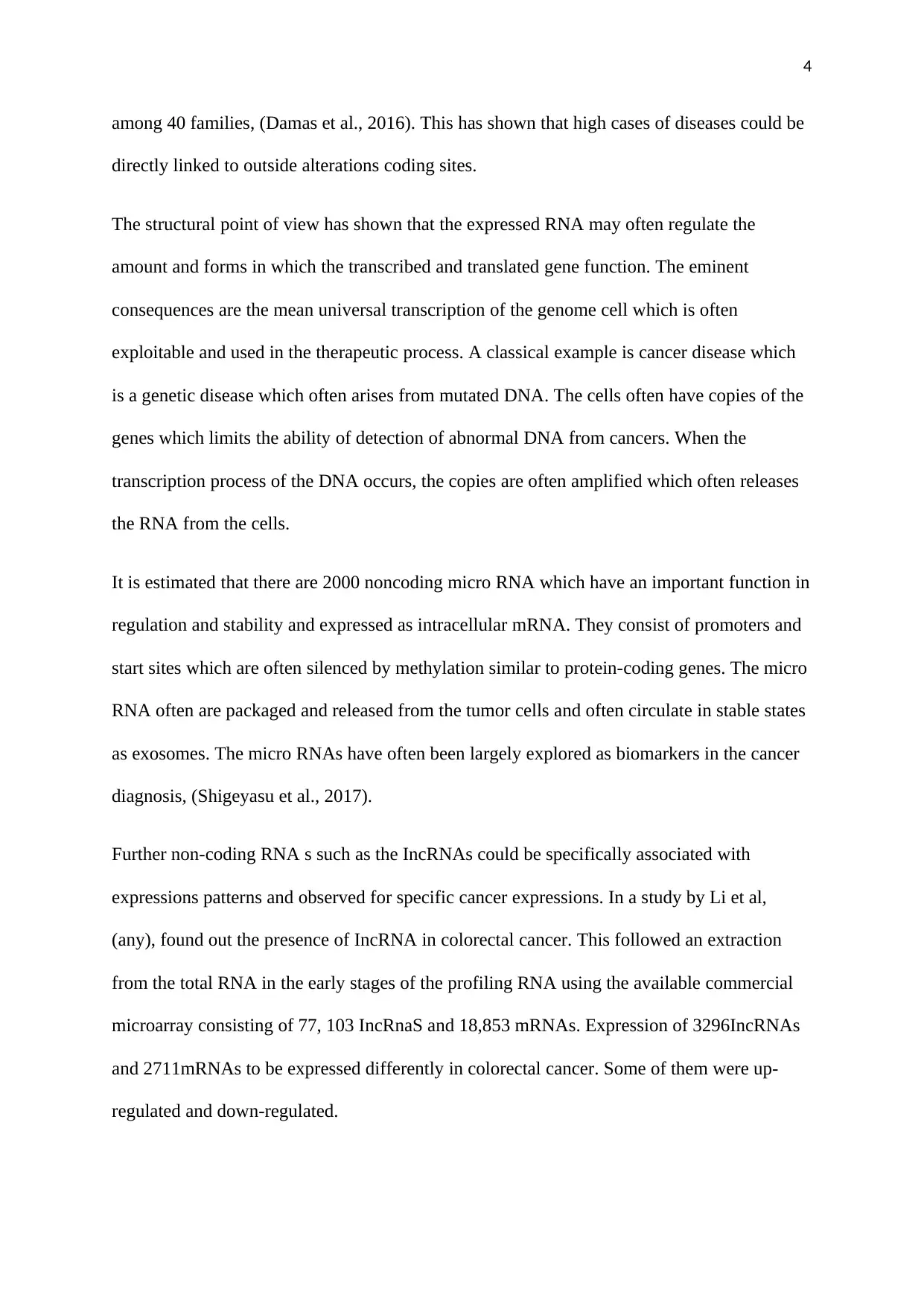
4
among 40 families, (Damas et al., 2016). This has shown that high cases of diseases could be
directly linked to outside alterations coding sites.
The structural point of view has shown that the expressed RNA may often regulate the
amount and forms in which the transcribed and translated gene function. The eminent
consequences are the mean universal transcription of the genome cell which is often
exploitable and used in the therapeutic process. A classical example is cancer disease which
is a genetic disease which often arises from mutated DNA. The cells often have copies of the
genes which limits the ability of detection of abnormal DNA from cancers. When the
transcription process of the DNA occurs, the copies are often amplified which often releases
the RNA from the cells.
It is estimated that there are 2000 noncoding micro RNA which have an important function in
regulation and stability and expressed as intracellular mRNA. They consist of promoters and
start sites which are often silenced by methylation similar to protein-coding genes. The micro
RNA often are packaged and released from the tumor cells and often circulate in stable states
as exosomes. The micro RNAs have often been largely explored as biomarkers in the cancer
diagnosis, (Shigeyasu et al., 2017).
Further non-coding RNA s such as the IncRNAs could be specifically associated with
expressions patterns and observed for specific cancer expressions. In a study by Li et al,
(any), found out the presence of IncRNA in colorectal cancer. This followed an extraction
from the total RNA in the early stages of the profiling RNA using the available commercial
microarray consisting of 77, 103 IncRnaS and 18,853 mRNAs. Expression of 3296IncRNAs
and 2711mRNAs to be expressed differently in colorectal cancer. Some of them were up-
regulated and down-regulated.
among 40 families, (Damas et al., 2016). This has shown that high cases of diseases could be
directly linked to outside alterations coding sites.
The structural point of view has shown that the expressed RNA may often regulate the
amount and forms in which the transcribed and translated gene function. The eminent
consequences are the mean universal transcription of the genome cell which is often
exploitable and used in the therapeutic process. A classical example is cancer disease which
is a genetic disease which often arises from mutated DNA. The cells often have copies of the
genes which limits the ability of detection of abnormal DNA from cancers. When the
transcription process of the DNA occurs, the copies are often amplified which often releases
the RNA from the cells.
It is estimated that there are 2000 noncoding micro RNA which have an important function in
regulation and stability and expressed as intracellular mRNA. They consist of promoters and
start sites which are often silenced by methylation similar to protein-coding genes. The micro
RNA often are packaged and released from the tumor cells and often circulate in stable states
as exosomes. The micro RNAs have often been largely explored as biomarkers in the cancer
diagnosis, (Shigeyasu et al., 2017).
Further non-coding RNA s such as the IncRNAs could be specifically associated with
expressions patterns and observed for specific cancer expressions. In a study by Li et al,
(any), found out the presence of IncRNA in colorectal cancer. This followed an extraction
from the total RNA in the early stages of the profiling RNA using the available commercial
microarray consisting of 77, 103 IncRnaS and 18,853 mRNAs. Expression of 3296IncRNAs
and 2711mRNAs to be expressed differently in colorectal cancer. Some of them were up-
regulated and down-regulated.
Paraphrase This Document
Need a fresh take? Get an instant paraphrase of this document with our AI Paraphraser
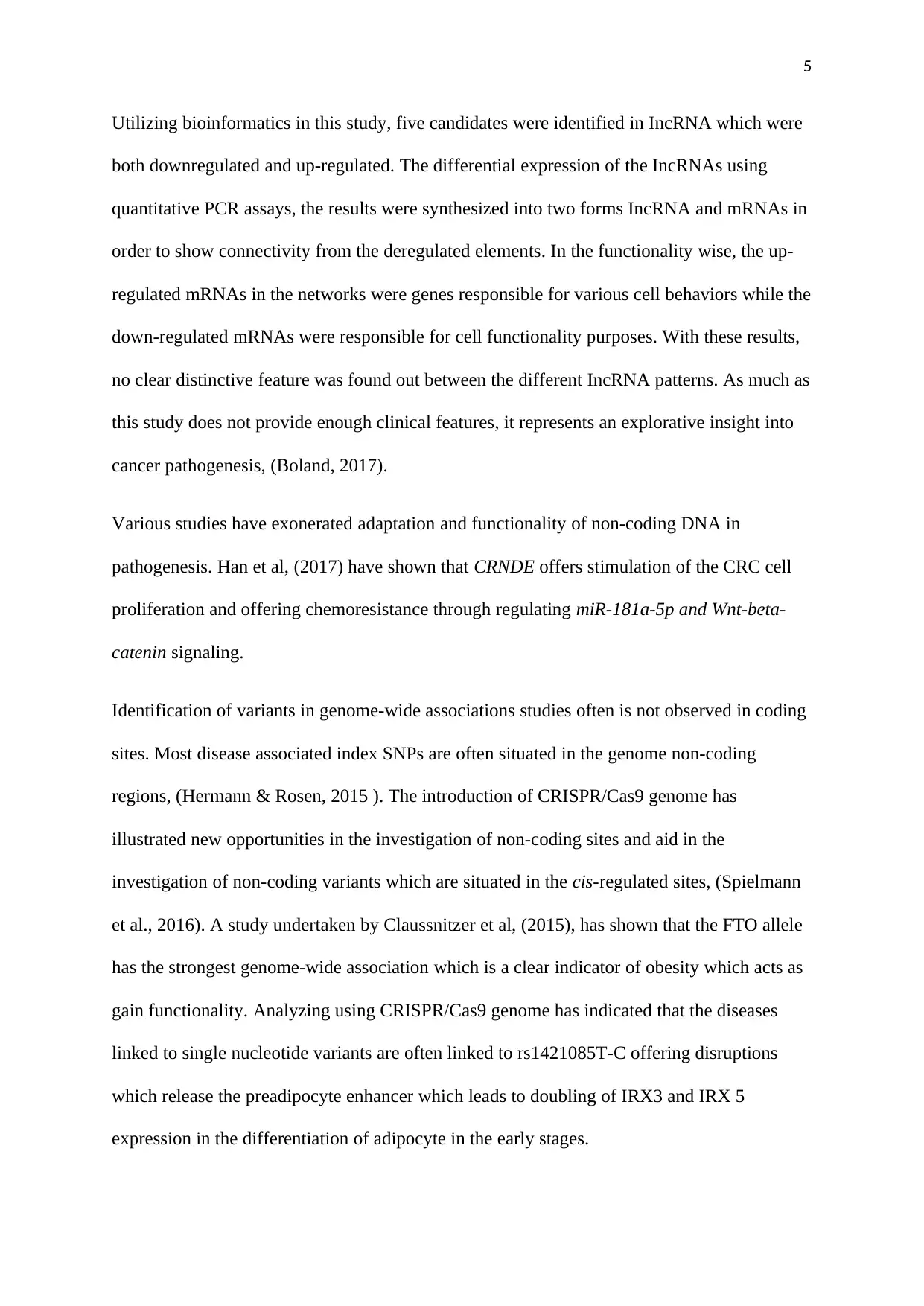
5
Utilizing bioinformatics in this study, five candidates were identified in IncRNA which were
both downregulated and up-regulated. The differential expression of the IncRNAs using
quantitative PCR assays, the results were synthesized into two forms IncRNA and mRNAs in
order to show connectivity from the deregulated elements. In the functionality wise, the up-
regulated mRNAs in the networks were genes responsible for various cell behaviors while the
down-regulated mRNAs were responsible for cell functionality purposes. With these results,
no clear distinctive feature was found out between the different IncRNA patterns. As much as
this study does not provide enough clinical features, it represents an explorative insight into
cancer pathogenesis, (Boland, 2017).
Various studies have exonerated adaptation and functionality of non-coding DNA in
pathogenesis. Han et al, (2017) have shown that CRNDE offers stimulation of the CRC cell
proliferation and offering chemoresistance through regulating miR-181a-5p and Wnt-beta-
catenin signaling.
Identification of variants in genome-wide associations studies often is not observed in coding
sites. Most disease associated index SNPs are often situated in the genome non-coding
regions, (Hermann & Rosen, 2015 ). The introduction of CRISPR/Cas9 genome has
illustrated new opportunities in the investigation of non-coding sites and aid in the
investigation of non-coding variants which are situated in the cis-regulated sites, (Spielmann
et al., 2016). A study undertaken by Claussnitzer et al, (2015), has shown that the FTO allele
has the strongest genome-wide association which is a clear indicator of obesity which acts as
gain functionality. Analyzing using CRISPR/Cas9 genome has indicated that the diseases
linked to single nucleotide variants are often linked to rs1421085T-C offering disruptions
which release the preadipocyte enhancer which leads to doubling of IRX3 and IRX 5
expression in the differentiation of adipocyte in the early stages.
Utilizing bioinformatics in this study, five candidates were identified in IncRNA which were
both downregulated and up-regulated. The differential expression of the IncRNAs using
quantitative PCR assays, the results were synthesized into two forms IncRNA and mRNAs in
order to show connectivity from the deregulated elements. In the functionality wise, the up-
regulated mRNAs in the networks were genes responsible for various cell behaviors while the
down-regulated mRNAs were responsible for cell functionality purposes. With these results,
no clear distinctive feature was found out between the different IncRNA patterns. As much as
this study does not provide enough clinical features, it represents an explorative insight into
cancer pathogenesis, (Boland, 2017).
Various studies have exonerated adaptation and functionality of non-coding DNA in
pathogenesis. Han et al, (2017) have shown that CRNDE offers stimulation of the CRC cell
proliferation and offering chemoresistance through regulating miR-181a-5p and Wnt-beta-
catenin signaling.
Identification of variants in genome-wide associations studies often is not observed in coding
sites. Most disease associated index SNPs are often situated in the genome non-coding
regions, (Hermann & Rosen, 2015 ). The introduction of CRISPR/Cas9 genome has
illustrated new opportunities in the investigation of non-coding sites and aid in the
investigation of non-coding variants which are situated in the cis-regulated sites, (Spielmann
et al., 2016). A study undertaken by Claussnitzer et al, (2015), has shown that the FTO allele
has the strongest genome-wide association which is a clear indicator of obesity which acts as
gain functionality. Analyzing using CRISPR/Cas9 genome has indicated that the diseases
linked to single nucleotide variants are often linked to rs1421085T-C offering disruptions
which release the preadipocyte enhancer which leads to doubling of IRX3 and IRX 5
expression in the differentiation of adipocyte in the early stages.
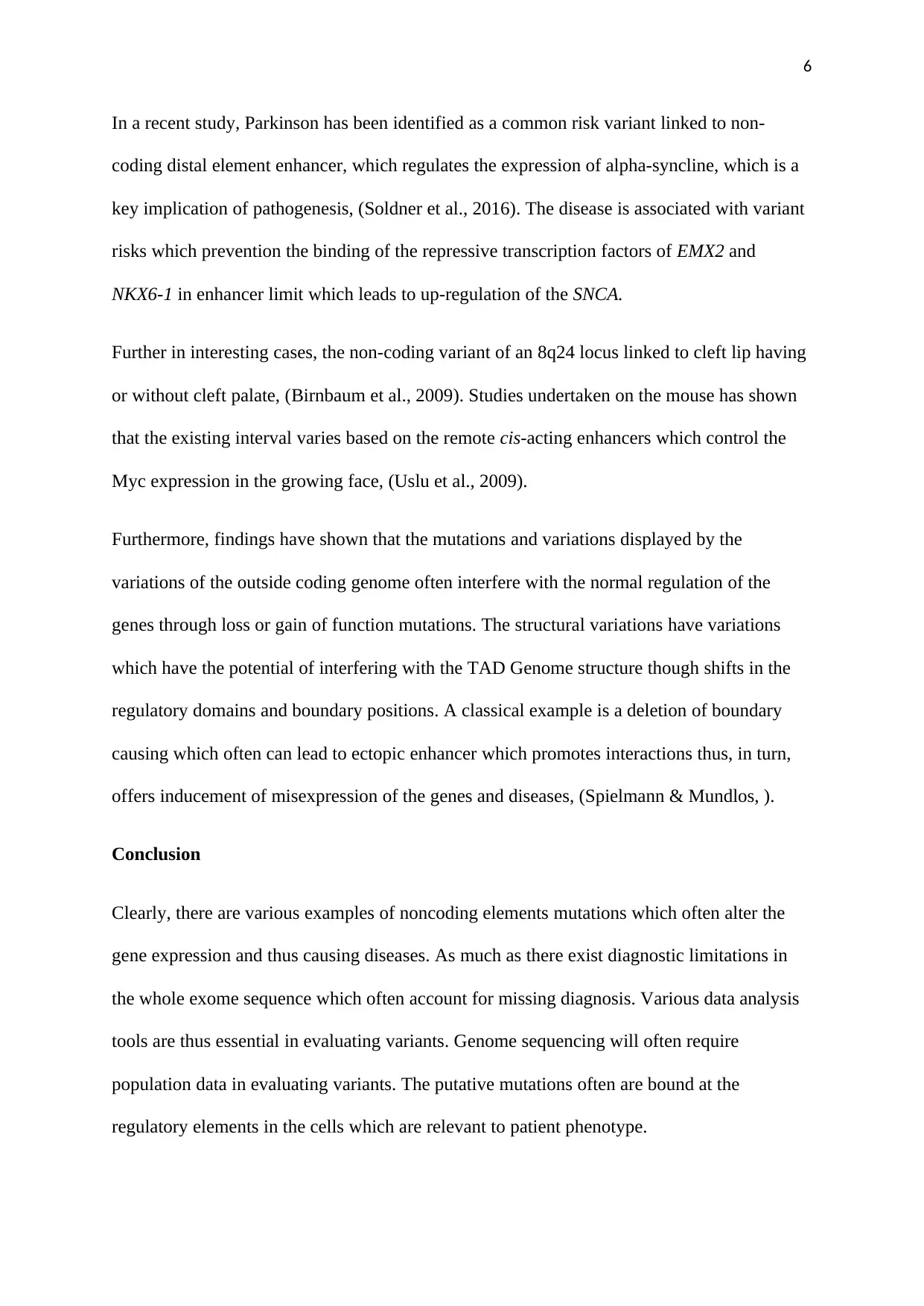
6
In a recent study, Parkinson has been identified as a common risk variant linked to non-
coding distal element enhancer, which regulates the expression of alpha-syncline, which is a
key implication of pathogenesis, (Soldner et al., 2016). The disease is associated with variant
risks which prevention the binding of the repressive transcription factors of EMX2 and
NKX6-1 in enhancer limit which leads to up-regulation of the SNCA.
Further in interesting cases, the non-coding variant of an 8q24 locus linked to cleft lip having
or without cleft palate, (Birnbaum et al., 2009). Studies undertaken on the mouse has shown
that the existing interval varies based on the remote cis-acting enhancers which control the
Myc expression in the growing face, (Uslu et al., 2009).
Furthermore, findings have shown that the mutations and variations displayed by the
variations of the outside coding genome often interfere with the normal regulation of the
genes through loss or gain of function mutations. The structural variations have variations
which have the potential of interfering with the TAD Genome structure though shifts in the
regulatory domains and boundary positions. A classical example is a deletion of boundary
causing which often can lead to ectopic enhancer which promotes interactions thus, in turn,
offers inducement of misexpression of the genes and diseases, (Spielmann & Mundlos, ).
Conclusion
Clearly, there are various examples of noncoding elements mutations which often alter the
gene expression and thus causing diseases. As much as there exist diagnostic limitations in
the whole exome sequence which often account for missing diagnosis. Various data analysis
tools are thus essential in evaluating variants. Genome sequencing will often require
population data in evaluating variants. The putative mutations often are bound at the
regulatory elements in the cells which are relevant to patient phenotype.
In a recent study, Parkinson has been identified as a common risk variant linked to non-
coding distal element enhancer, which regulates the expression of alpha-syncline, which is a
key implication of pathogenesis, (Soldner et al., 2016). The disease is associated with variant
risks which prevention the binding of the repressive transcription factors of EMX2 and
NKX6-1 in enhancer limit which leads to up-regulation of the SNCA.
Further in interesting cases, the non-coding variant of an 8q24 locus linked to cleft lip having
or without cleft palate, (Birnbaum et al., 2009). Studies undertaken on the mouse has shown
that the existing interval varies based on the remote cis-acting enhancers which control the
Myc expression in the growing face, (Uslu et al., 2009).
Furthermore, findings have shown that the mutations and variations displayed by the
variations of the outside coding genome often interfere with the normal regulation of the
genes through loss or gain of function mutations. The structural variations have variations
which have the potential of interfering with the TAD Genome structure though shifts in the
regulatory domains and boundary positions. A classical example is a deletion of boundary
causing which often can lead to ectopic enhancer which promotes interactions thus, in turn,
offers inducement of misexpression of the genes and diseases, (Spielmann & Mundlos, ).
Conclusion
Clearly, there are various examples of noncoding elements mutations which often alter the
gene expression and thus causing diseases. As much as there exist diagnostic limitations in
the whole exome sequence which often account for missing diagnosis. Various data analysis
tools are thus essential in evaluating variants. Genome sequencing will often require
population data in evaluating variants. The putative mutations often are bound at the
regulatory elements in the cells which are relevant to patient phenotype.
⊘ This is a preview!⊘
Do you want full access?
Subscribe today to unlock all pages.

Trusted by 1+ million students worldwide
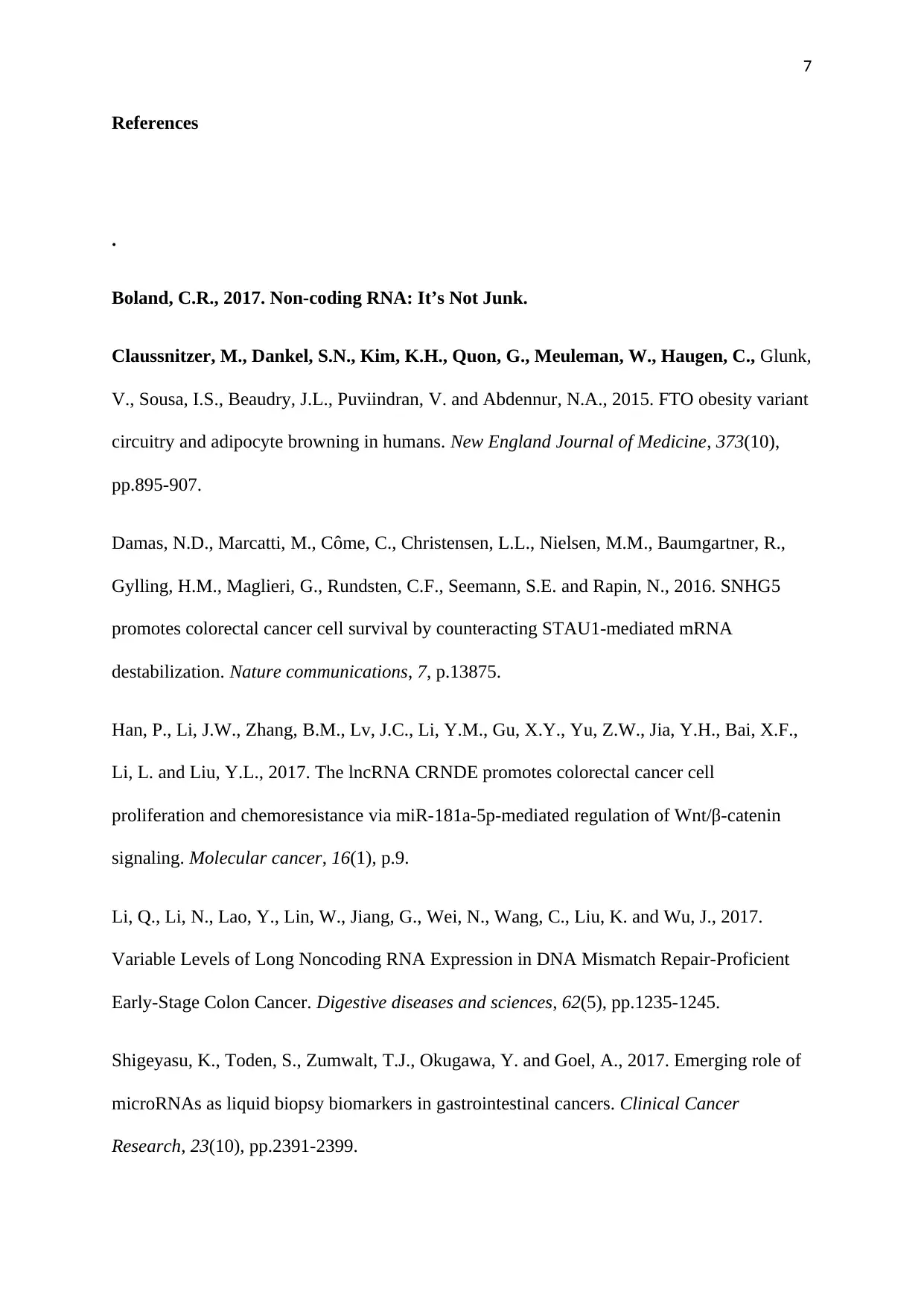
7
References
.
Boland, C.R., 2017. Non-coding RNA: It’s Not Junk.
Claussnitzer, M., Dankel, S.N., Kim, K.H., Quon, G., Meuleman, W., Haugen, C., Glunk,
V., Sousa, I.S., Beaudry, J.L., Puviindran, V. and Abdennur, N.A., 2015. FTO obesity variant
circuitry and adipocyte browning in humans. New England Journal of Medicine, 373(10),
pp.895-907.
Damas, N.D., Marcatti, M., Côme, C., Christensen, L.L., Nielsen, M.M., Baumgartner, R.,
Gylling, H.M., Maglieri, G., Rundsten, C.F., Seemann, S.E. and Rapin, N., 2016. SNHG5
promotes colorectal cancer cell survival by counteracting STAU1-mediated mRNA
destabilization. Nature communications, 7, p.13875.
Han, P., Li, J.W., Zhang, B.M., Lv, J.C., Li, Y.M., Gu, X.Y., Yu, Z.W., Jia, Y.H., Bai, X.F.,
Li, L. and Liu, Y.L., 2017. The lncRNA CRNDE promotes colorectal cancer cell
proliferation and chemoresistance via miR-181a-5p-mediated regulation of Wnt/β-catenin
signaling. Molecular cancer, 16(1), p.9.
Li, Q., Li, N., Lao, Y., Lin, W., Jiang, G., Wei, N., Wang, C., Liu, K. and Wu, J., 2017.
Variable Levels of Long Noncoding RNA Expression in DNA Mismatch Repair-Proficient
Early-Stage Colon Cancer. Digestive diseases and sciences, 62(5), pp.1235-1245.
Shigeyasu, K., Toden, S., Zumwalt, T.J., Okugawa, Y. and Goel, A., 2017. Emerging role of
microRNAs as liquid biopsy biomarkers in gastrointestinal cancers. Clinical Cancer
Research, 23(10), pp.2391-2399.
References
.
Boland, C.R., 2017. Non-coding RNA: It’s Not Junk.
Claussnitzer, M., Dankel, S.N., Kim, K.H., Quon, G., Meuleman, W., Haugen, C., Glunk,
V., Sousa, I.S., Beaudry, J.L., Puviindran, V. and Abdennur, N.A., 2015. FTO obesity variant
circuitry and adipocyte browning in humans. New England Journal of Medicine, 373(10),
pp.895-907.
Damas, N.D., Marcatti, M., Côme, C., Christensen, L.L., Nielsen, M.M., Baumgartner, R.,
Gylling, H.M., Maglieri, G., Rundsten, C.F., Seemann, S.E. and Rapin, N., 2016. SNHG5
promotes colorectal cancer cell survival by counteracting STAU1-mediated mRNA
destabilization. Nature communications, 7, p.13875.
Han, P., Li, J.W., Zhang, B.M., Lv, J.C., Li, Y.M., Gu, X.Y., Yu, Z.W., Jia, Y.H., Bai, X.F.,
Li, L. and Liu, Y.L., 2017. The lncRNA CRNDE promotes colorectal cancer cell
proliferation and chemoresistance via miR-181a-5p-mediated regulation of Wnt/β-catenin
signaling. Molecular cancer, 16(1), p.9.
Li, Q., Li, N., Lao, Y., Lin, W., Jiang, G., Wei, N., Wang, C., Liu, K. and Wu, J., 2017.
Variable Levels of Long Noncoding RNA Expression in DNA Mismatch Repair-Proficient
Early-Stage Colon Cancer. Digestive diseases and sciences, 62(5), pp.1235-1245.
Shigeyasu, K., Toden, S., Zumwalt, T.J., Okugawa, Y. and Goel, A., 2017. Emerging role of
microRNAs as liquid biopsy biomarkers in gastrointestinal cancers. Clinical Cancer
Research, 23(10), pp.2391-2399.
Paraphrase This Document
Need a fresh take? Get an instant paraphrase of this document with our AI Paraphraser
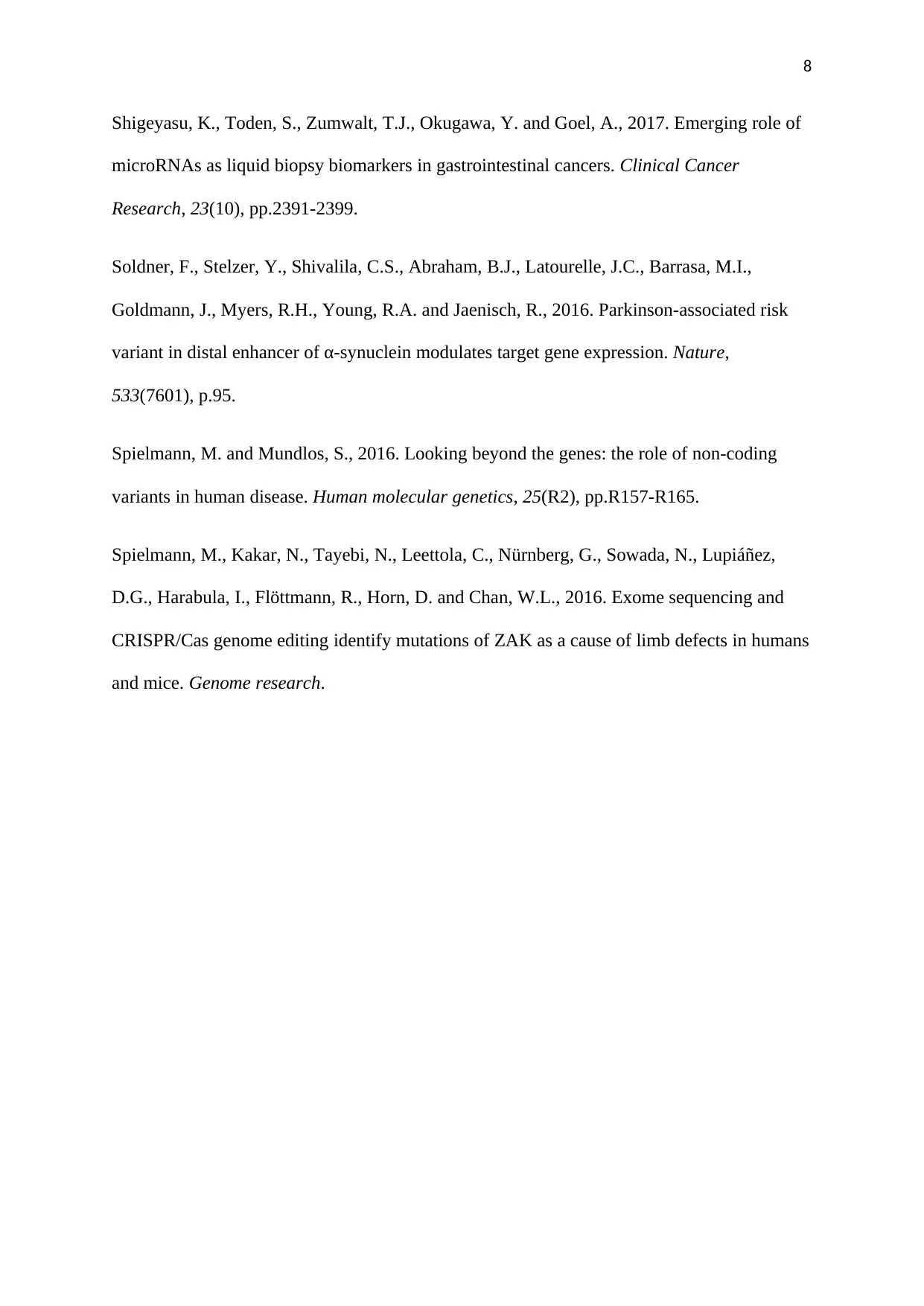
8
Shigeyasu, K., Toden, S., Zumwalt, T.J., Okugawa, Y. and Goel, A., 2017. Emerging role of
microRNAs as liquid biopsy biomarkers in gastrointestinal cancers. Clinical Cancer
Research, 23(10), pp.2391-2399.
Soldner, F., Stelzer, Y., Shivalila, C.S., Abraham, B.J., Latourelle, J.C., Barrasa, M.I.,
Goldmann, J., Myers, R.H., Young, R.A. and Jaenisch, R., 2016. Parkinson-associated risk
variant in distal enhancer of α-synuclein modulates target gene expression. Nature,
533(7601), p.95.
Spielmann, M. and Mundlos, S., 2016. Looking beyond the genes: the role of non-coding
variants in human disease. Human molecular genetics, 25(R2), pp.R157-R165.
Spielmann, M., Kakar, N., Tayebi, N., Leettola, C., Nürnberg, G., Sowada, N., Lupiáñez,
D.G., Harabula, I., Flöttmann, R., Horn, D. and Chan, W.L., 2016. Exome sequencing and
CRISPR/Cas genome editing identify mutations of ZAK as a cause of limb defects in humans
and mice. Genome research.
Shigeyasu, K., Toden, S., Zumwalt, T.J., Okugawa, Y. and Goel, A., 2017. Emerging role of
microRNAs as liquid biopsy biomarkers in gastrointestinal cancers. Clinical Cancer
Research, 23(10), pp.2391-2399.
Soldner, F., Stelzer, Y., Shivalila, C.S., Abraham, B.J., Latourelle, J.C., Barrasa, M.I.,
Goldmann, J., Myers, R.H., Young, R.A. and Jaenisch, R., 2016. Parkinson-associated risk
variant in distal enhancer of α-synuclein modulates target gene expression. Nature,
533(7601), p.95.
Spielmann, M. and Mundlos, S., 2016. Looking beyond the genes: the role of non-coding
variants in human disease. Human molecular genetics, 25(R2), pp.R157-R165.
Spielmann, M., Kakar, N., Tayebi, N., Leettola, C., Nürnberg, G., Sowada, N., Lupiáñez,
D.G., Harabula, I., Flöttmann, R., Horn, D. and Chan, W.L., 2016. Exome sequencing and
CRISPR/Cas genome editing identify mutations of ZAK as a cause of limb defects in humans
and mice. Genome research.
1 out of 8
Related Documents
Your All-in-One AI-Powered Toolkit for Academic Success.
+13062052269
info@desklib.com
Available 24*7 on WhatsApp / Email
![[object Object]](/_next/static/media/star-bottom.7253800d.svg)
Unlock your academic potential
Copyright © 2020–2025 A2Z Services. All Rights Reserved. Developed and managed by ZUCOL.





